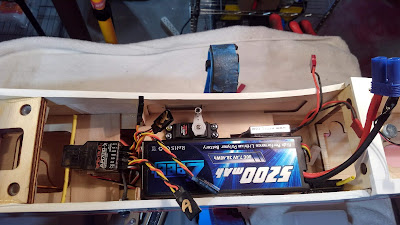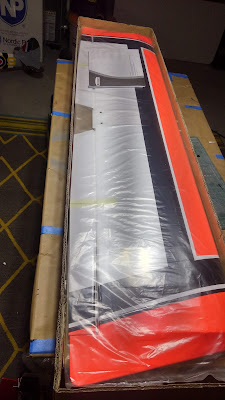Sunday, September 27, 2020
Ultra Stick 10cc Build Day 3
Saturday, September 26, 2020
Ultra Stick 10cc ARF Build Progress
Friday, September 25, 2020
Hangar 9 Ultra Stick 10cc ARF Build Begins
Thursday, September 24, 2020
Spitfire RCGF 10cc Blow Out
I have been working on this RCGF 10cc engine for a few weeks on the Spitfire. I rebuilt the carburetor and did a thing fixing the stripped sparky with an adapter. I got it running finally today! Decent albeit slightly high idle, nice smooth acceleration, and a powerful WOT with 5.2 lbs thrust swinging the 14x6 Master Airscrew! And then all of the sudden I couldn't get it to run. What the heck? Wait, no compression? Turns out the pressure and heat blew the stainless adapter out of the crappy metal cylinder of this first generation RCGF engine. This problem of soft metal has been addressed in the current RCGF-USA 10cc engines.
Saturday, September 19, 2020
Faith Restored: Evolution 10cc runs perfectly!
Friday, September 18, 2020
New shop floor "covering"
Wednesday, September 16, 2020
450 FBL Update
Tuesday, September 15, 2020
Defeat
I may put the other RCGF 10cc on the engine stand, the one on the Spitty. I have had problems finding a nice low needle that idles well and accelerates well. Not sure, may just test it on the plane as is. I don't want to put the Evo 10cc on it, would need to see if the RCGF muffler fits as I am not putting the huge torpedo muffler on the Spitty, and also because I kinda think its weaker than the RCGF though I have no objective support for that. I had just found its sweet spot when I crashed the Sbach, so it was running perfectly. I'll give the RCGF a chance on the Spitty, but may replace it... we'll see.
New GT Power Servo Tester
My basic Turnigy servo tester is over 10 yrs old and was starting to show its age. In those 10 yrs I have also wanted to know things about my servos it couldn't tell me, like speed, dead band, etc. So it was time to replace it with an upgrade. I found the GT Power Professional Servo Tester on eBay for $30 shipped from hangarstuff4sale (gave you the MotionRC listing for detail). I put it on a switch since it doesn't have an I/O switch, it turns on when powered up as far as I can tell, which meant it was going to need a platform, and here it is! I can easily charge the pack through the switch. Built a little box with a hatch to cover and contain the wires, used on old NiMH recieiver pack, some paint and Dual Lock and voila!
My trusty blue Turnigy tester will be hanging around for a while, for sentimental reasons.
Monday, September 14, 2020
Walbro 10cc Carb Update
I took the cleaned carb out attached to the RCGF-USA 10cc on the test stand.
Saturday, September 12, 2020
Updated Engine Test Bed!
I needed my test platform to work on my 10cc carb problems, and I wanted to update it a bit. Put a throttle servo and an Orange receiver on it, added a second battery pack so I can run longer. Added a hole behind the engine to increase air intake airflow.
Cleaning a Walbro Carb
I've been having carb problems. Pretty much anytime you have trouble with an engine, its the carb. The ignition and wires are second on the list. The rest of it is pretty tough and resilient to problems. I have been having issues with the carbs on both 10cc engines. These little buggers have such small tolerances for mixture that any debris or clog, and air leak, can cause weird stuff to happen that causes gnashing of teeth, sore backs from standing way too long to solve a problem trying the same thing over and over again because what you are doing is supposed to solve the problem. The machines are not hard, they just are complex. You've been there, don't lie.. If there was one thing I hate about gas its that the smaller engines are so unreliable day to day. The 20cc and bigger, probably the 15cc too but I don't have any, are so much more stable. So when someone tells you gas is reliable, they don't fly less than 10cc. Remember, the engine is fine, its almost always the carb.
I use this with the little red tube to blow out the passages and soak the carb.


























































